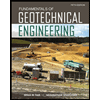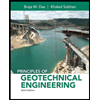3.15 In a site consisting of normally consolidated clean sands, the water table is at 10 ft depth. The average unit weight of the sand above and below the water table is 111.5 lb/ft3 and 125.0 lb/ft3, respectively. At a 25 ft depth, Nso was reported as 26. Determine the following: a. (N160 using Liao and Whitman's (1986) equation for CN [Eq. (3.13)] b. D, using Skempton's (1986) correlation [Eq. (3.28)] c. Friction angle using Schmertmann's (1975) correlation [Eq. (3.30)] d. Modulus of elasticity using Kulhawy and Mayne's (1990) correlation [Eq. (3.32)]
3.15 In a site consisting of normally consolidated clean sands, the water table is at 10 ft depth. The average unit weight of the sand above and below the water table is 111.5 lb/ft3 and 125.0 lb/ft3, respectively. At a 25 ft depth, Nso was reported as 26. Determine the following: a. (N160 using Liao and Whitman's (1986) equation for CN [Eq. (3.13)] b. D, using Skempton's (1986) correlation [Eq. (3.28)] c. Friction angle using Schmertmann's (1975) correlation [Eq. (3.30)] d. Modulus of elasticity using Kulhawy and Mayne's (1990) correlation [Eq. (3.32)]
Principles of Foundation Engineering (MindTap Course List)
9th Edition
ISBN:9781337705028
Author:Braja M. Das, Nagaratnam Sivakugan
Publisher:Braja M. Das, Nagaratnam Sivakugan
Chapter3: Natural Soil Deposits And Subsoil Exploration
Section: Chapter Questions
Problem 3.15P
Related questions
Question
![3.15
In a site consisting of normally consolidated clean sands,
the water table is at 10 ft depth. The average unit weight of
the sand above and below the water table is 111.5 lb/ft3 and
125.0 lb/ft3, respectively. At a 25 ft depth, Nso was reported
as 26. Determine the following:
a. (N160 using Liao and Whitman's (1986) equation for CN
[Eq. (3.13)]
b. D, using Skempton's (1986) correlation [Eq. (3.28)]
c. Friction angle using Schmertmann's (1975) correlation
[Eq. (3.30)]
d. Modulus of elasticity using Kulhawy and Mayne's (1990)
correlation [Eq. (3.32)]](/v2/_next/image?url=https%3A%2F%2Fcontent.bartleby.com%2Fqna-images%2Fquestion%2F4993b414-a52b-4318-b981-fb4926dbe79c%2F072088a9-00d1-4c0e-9912-91b528f447b9%2F25lu5l.jpeg&w=3840&q=75)
Transcribed Image Text:3.15
In a site consisting of normally consolidated clean sands,
the water table is at 10 ft depth. The average unit weight of
the sand above and below the water table is 111.5 lb/ft3 and
125.0 lb/ft3, respectively. At a 25 ft depth, Nso was reported
as 26. Determine the following:
a. (N160 using Liao and Whitman's (1986) equation for CN
[Eq. (3.13)]
b. D, using Skempton's (1986) correlation [Eq. (3.28)]
c. Friction angle using Schmertmann's (1975) correlation
[Eq. (3.30)]
d. Modulus of elasticity using Kulhawy and Mayne's (1990)
correlation [Eq. (3.32)]
Expert Solution
This question has been solved!
Explore an expertly crafted, step-by-step solution for a thorough understanding of key concepts.
This is a popular solution!
Trending now
This is a popular solution!
Step by step
Solved in 5 steps with 4 images

Recommended textbooks for you

Principles of Foundation Engineering (MindTap Cou…
Civil Engineering
ISBN:
9781337705028
Author:
Braja M. Das, Nagaratnam Sivakugan
Publisher:
Cengage Learning

Fundamentals of Geotechnical Engineering (MindTap…
Civil Engineering
ISBN:
9781305635180
Author:
Braja M. Das, Nagaratnam Sivakugan
Publisher:
Cengage Learning

Principles of Geotechnical Engineering (MindTap C…
Civil Engineering
ISBN:
9781305970939
Author:
Braja M. Das, Khaled Sobhan
Publisher:
Cengage Learning

Principles of Foundation Engineering (MindTap Cou…
Civil Engineering
ISBN:
9781337705028
Author:
Braja M. Das, Nagaratnam Sivakugan
Publisher:
Cengage Learning

Fundamentals of Geotechnical Engineering (MindTap…
Civil Engineering
ISBN:
9781305635180
Author:
Braja M. Das, Nagaratnam Sivakugan
Publisher:
Cengage Learning

Principles of Geotechnical Engineering (MindTap C…
Civil Engineering
ISBN:
9781305970939
Author:
Braja M. Das, Khaled Sobhan
Publisher:
Cengage Learning